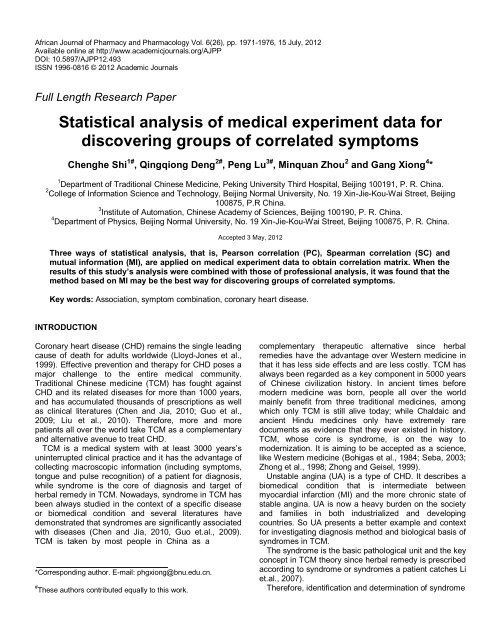Download Complete Issue (pdf 3800kb) - Academic Journals
Download Complete Issue (pdf 3800kb) - Academic Journals
Download Complete Issue (pdf 3800kb) - Academic Journals
Create successful ePaper yourself
Turn your PDF publications into a flip-book with our unique Google optimized e-Paper software.
African Journal of Pharmacy and Pharmacology Vol. 6(26), pp. 1971-1976, 15 July, 2012<br />
Available online at http://www.academicjournals.org/AJPP<br />
DOI: 10.5897/AJPP12.493<br />
ISSN 1996-0816 © 2012 <strong>Academic</strong> <strong>Journals</strong><br />
Full Length Research Paper<br />
Statistical analysis of medical experiment data for<br />
discovering groups of correlated symptoms<br />
Chenghe Shi 1# , Qingqiong Deng 2# , Peng Lu 3# , Minquan Zhou 2 and Gang Xiong 4 *<br />
1 Department of Traditional Chinese Medicine, Peking University Third Hospital, Beijing 100191, P. R. China.<br />
2 College of Information Science and Technology, Beijing Normal University, No. 19 Xin-Jie-Kou-Wai Street, Beijing<br />
100875, P.R China.<br />
3 Institute of Automation, Chinese Academy of Sciences, Beijing 100190, P. R. China.<br />
4 Department of Physics, Beijing Normal University, No. 19 Xin-Jie-Kou-Wai Street, Beijing 100875, P. R. China.<br />
Accepted 3 May, 2012<br />
Three ways of statistical analysis, that is, Pearson correlation (PC), Spearman correlation (SC) and<br />
mutual information (MI), are applied on medical experiment data to obtain correlation matrix. When the<br />
results of this study’s analysis were combined with those of professional analysis, it was found that the<br />
method based on MI may be the best way for discovering groups of correlated symptoms.<br />
Key words: Association, symptom combination, coronary heart disease.<br />
INTRODUCTION<br />
Coronary heart disease (CHD) remains the single leading<br />
cause of death for adults worldwide (Lloyd-Jones et al.,<br />
1999). Effective prevention and therapy for CHD poses a<br />
major challenge to the entire medical community.<br />
Traditional Chinese medicine (TCM) has fought against<br />
CHD and its related diseases for more than 1000 years,<br />
and has accumulated thousands of prescriptions as well<br />
as clinical literatures (Chen and Jia, 2010; Guo et al.,<br />
2009; Liu et al., 2010). Therefore, more and more<br />
patients all over the world take TCM as a complementary<br />
and alternative avenue to treat CHD.<br />
TCM is a medical system with at least 3000 years’s<br />
uninterrupted clinical practice and it has the advantage of<br />
collecting macroscopic information (including symptoms,<br />
tongue and pulse recognition) of a patient for diagnosis,<br />
while syndrome is the core of diagnosis and target of<br />
herbal remedy in TCM. Nowadays, syndrome in TCM has<br />
been always studied in the context of a specific disease<br />
or biomedical condition and several literatures have<br />
demonstrated that syndromes are significantly associated<br />
with diseases (Chen and Jia, 2010, Guo et.al., 2009).<br />
TCM is taken by most people in China as a<br />
*Corresponding author. E-mail: phgxiong@bnu.edu.cn.<br />
# These authors contributed equally to this work.<br />
complementary therapeutic alternative since herbal<br />
remedies have the advantage over Western medicine in<br />
that it has less side effects and are less costly. TCM has<br />
always been regarded as a key component in 5000 years<br />
of Chinese civilization history. In ancient times before<br />
modern medicine was born, people all over the world<br />
mainly benefit from three traditional medicines, among<br />
which only TCM is still alive today; while Chaldaic and<br />
ancient Hindu medicines only have extremely rare<br />
documents as evidence that they ever existed in history.<br />
TCM, whose core is syndrome, is on the way to<br />
modernization. It is aiming to be accepted as a science,<br />
like Western medicine (Bohigas et al., 1984; Seba, 2003;<br />
Zhong et al., 1998; Zhong and Geisel, 1999).<br />
Unstable angina (UA) is a type of CHD. It describes a<br />
biomedical condition that is intermediate between<br />
myocardial infarction (MI) and the more chronic state of<br />
stable angina. UA is now a heavy burden on the society<br />
and families in both industrialized and developing<br />
countries. So UA presents a better example and context<br />
for investigating diagnosis method and biological basis of<br />
syndromes in TCM.<br />
The syndrome is the basic pathological unit and the key<br />
concept in TCM theory since herbal remedy is prescribed<br />
according to syndrome or syndromes a patient catches Li<br />
et.al., 2007).<br />
Therefore, identification and determination of syndrome

















